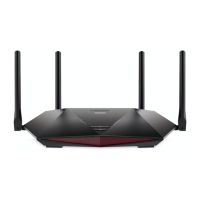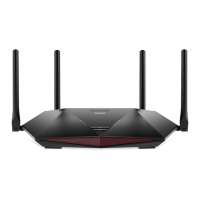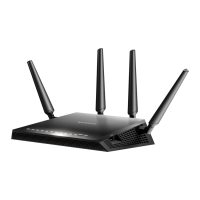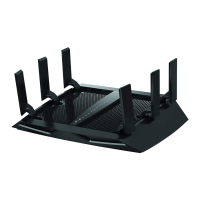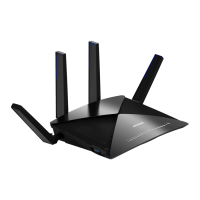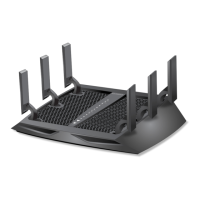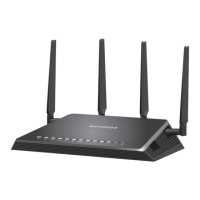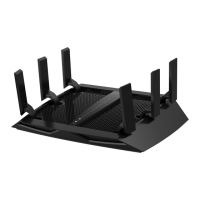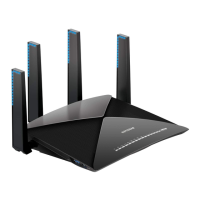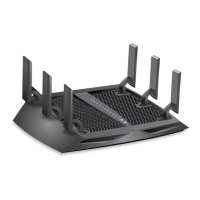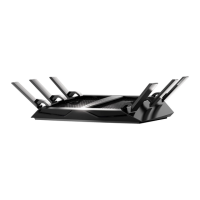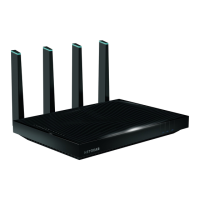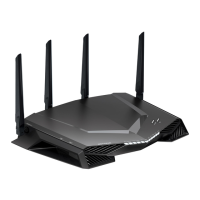
Do you have a question about the NETGEAR Nighthawk Pro Gaming XR500 and is the answer not in the manual?
| DSL WAN | No |
|---|---|
| Ethernet WAN | Yes |
| WAN connection type | RJ-45 |
| Security algorithms | WPA, WPA2-PSK |
| Modulation | 256-QAM |
| Wi-Fi band | Dual-band (2.4 GHz / 5 GHz) |
| Wi-Fi standards | 802.11a, Wi-Fi 5 (802.11ac), 802.11b, 802.11g, Wi-Fi 4 (802.11n) |
| Top Wi-Fi standard | Wi-Fi 5 (802.11ac) |
| WLAN data transfer rate (max) | 1733 Mbit/s |
| WLAN data transfer rate (first band) | 800 Mbit/s |
| Product type | Tabletop router |
| Product color | Black |
| Cabling technology | 10/100/1000Base-T(X) |
| Networking standards | IEEE 802.11a, IEEE 802.11ac, IEEE 802.11b, IEEE 802.11g, IEEE 802.11n |
| Ethernet LAN data rates | 10, 100, 1000 Mbit/s |
| Ethernet LAN interface type | Gigabit Ethernet |
| Processor cores | 2 |
| Processor frequency | 1700 MHz |
| Memory card slot(s) | - |
| Ethernet LAN (RJ-45) ports | 4 |
| Power source type | DC |
| Supported network protocols | IPv6 |
| Number of products included | 1 pc(s) |
| Cables included | LAN (RJ-45) |
| Windows operating systems supported | Windows 10, Windows 2000, Windows 7, Windows 8, Windows Vista, Windows XP |
| Depth | 243.7 mm |
|---|---|
| Width | 321.9 mm |
| Height | 55 mm |
| Weight | 801 g |
Instructions on unpacking the Nighthawk Pro Gaming Router and its accessories.
Describes LEDs, buttons, and ports on the front, top, left, and rear panels of the router.
Guide on how to attach and position the router's antennas for optimal WiFi performance.
Information on the router label and guidelines for optimal router placement.
Instructions for connecting the router and controlling its LED indicators.
Steps to connect devices via wired Ethernet or WiFi to the router.
Guide to accessing router settings via a web browser interface and automatic setup.
Instructions on how to log in to the router's web interface using admin credentials.
Using the mobile app to manage router features, firmware, and settings.
Using the setup wizard or manually configuring the router's internet connection.
Configuring IPv6 internet connection types like Auto Detect, Auto Config, and tunnels.
Adjusting the Maximum Transmission Unit (MTU) size for network packets.
Using Geo Filter to limit game server distance for better response time.
Allocating bandwidth to specific devices to manage network congestion.
Prioritizing network traffic for specific devices or applications.
Viewing and managing connected devices, including blocking access.
Monitoring network traffic, categories, and applications using DPI.
Accessing router system details like CPU, RAM, and flash memory usage.
Personalizing the router dashboard by adding, removing, or rearranging panes.
Blocking specific websites or domains using keywords.
Using outbound firewall rules to block specific services and applications.
Creating schedules for when blocking rules are active.
Configuring email alerts for security events and router logs.
Configuring Wide Area Network (WAN) settings for internet connectivity.
Configuring a DMZ server for specific applications, potentially reducing firewall security.
Changing LAN IP address, managing reserved IPs, and disabling DHCP server.
Bridging to ISP network and managing custom static routes for traffic.
Configuring fundamental WiFi settings like SSID, security, and bands.
Modifying the WiFi password and security protocol (WPA2/WPA).
Creating a separate WiFi network for guests with limited access.
Controlling WiFi radios, WPS, schedules, beamforming, MU-MIMO, and HT160.
Checking for and installing new router firmware for updates and security.
Changing the admin password and setting up password recovery options.
Backing up, restoring, or resetting router configuration settings.
Monitoring internet traffic volume, setting limits, and viewing usage updates.
Tips for restarting the network and checking cable connections, settings, and LEDs.
Steps to resolve issues preventing login or internet access.
Diagnosing and resolving problems connecting to the WiFi network.
Specifications for USB devices and steps to connect them to the router.
Accessing USB storage from Windows and Mac computers via network.
Using ReadySHARE Vault (Windows) and Time Machine (Mac) for computer backups.
Configuring access methods, folders, and approving USB devices.
Configuring a personal FTP server and Dynamic DNS for remote network access.
Accessing USB storage remotely via the Internet and setting up FTP access.
Configuring the router as a DLNA/UPnP AV media server for devices.
Setting up the router's iTunes server for music playback via iTunes and Remote App.
Configuring the router to share media files with TiVo devices.
Installing printer drivers and the ReadySHARE printer utility.
Using the NETGEAR USB Control Center to manage and print via the shared USB printer.
Establishing a VPN connection and configuring router's VPN service settings.
Installing OpenVPN client software on Windows, Mac, iOS, and Android devices.
Establishing a VPN tunnel and accessing home internet service or USB storage remotely.
Setting up the router to act as a VPN client to access external networks.
Enabling the router's VPN client and connecting to a VPN server.
Terminating the VPN connection by disconnecting the router from the VPN server.
Configuring port forwarding to make local servers accessible over the internet.
Configuring port triggering to dynamically open ports for services.
General troubleshooting tips and steps for restarting the network.
Diagnosing issues by observing the status and behavior of router LEDs.
Steps to resolve issues preventing login or internet access.
Diagnosing and resolving problems connecting to the WiFi network.
Using the ping utility to test network connectivity and diagnose path issues.
Details of the router's default factory settings.
Technical details and specifications of the router hardware.
